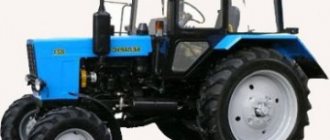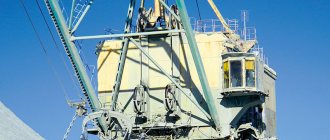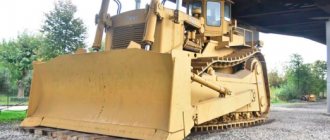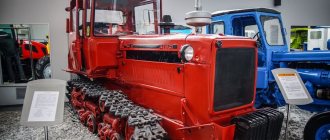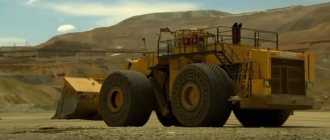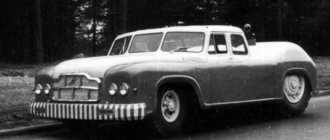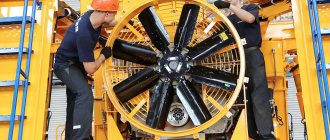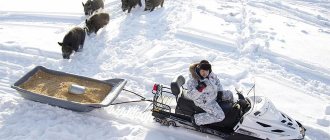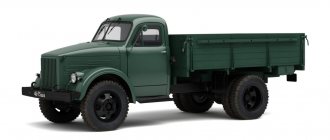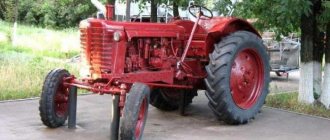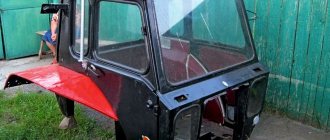Author: Dimon
03 February 2022 23:13
Tags: educational techniques top 10
10977
11
From time immemorial, man has been inventing new and more advanced tools. This applied to all spheres of life, but the most important was always the sphere of agriculture. A long time ago, people domesticated the horse, and in some countries, bulls, to facilitate cultivation of the land.
0
See all photos in the gallery
With the advent of the steam engine, engineers developed machines that were superior to human assistants in terms of power and the amount of work they could perform. Over time, people achieved perfection and developed tractors and bulldozers that saved many people from hunger and hard, sometimes backbreaking work. Our rating today is dedicated to hard workers who, for their work, require only high-quality fuel and timely care. So, we present to you the 10 largest tractors in the world.
Terra Variant-600
0
The Terra Variant-600 tractor is considered the most powerful unit in Europe. It is equipped with either an engine with a capacity of 490 or 612 horsepower. The tractor is equipped with a special body, which helps to perform the function of spreading fertilizers and limestone. A plow for processing and plowing the soil, or equipment for sowing, is also installed. In addition, Terra Variant-600 is capable of transporting beets and wheat. The length is more than ten meters, the width is three, and the height is almost four meters. The weight of the giant is 17 tons. The fuel tank holds 830 liters. The width of the wheels is a whole meter. The tractor reaches a maximum speed of 40 kilometers per hour.
Big Bud 747
But the leader in terms of power by a huge margin is the mighty Big Bud 747. It was made in 1977 and is still the largest farm tractor in the world. And also the most powerful.
Its 16-cylinder Detroit Diesel 16V92T with two turbochargers and two turbochargers produces 1,100 hp in the latest iteration. Recently, the only released copy has been practically inactive, occasionally appearing at various events from the museum in Clarion.
Subscribe to our Telegram channel
Melrose-M880
0
The giant, weighing 102 tons, was created in the American state of Colorado, in the city of Denver. Melrose-M880, created by the Melrose company, is a bulldozer on which wheels are installed instead of the usual tracks. The decision to install wheelsets is justified by many factors. For example, efficiency, reduced noise levels, increased speed and productivity. Another innovation was the installation of two engines at once, with a total power of 850 horsepower. These machines cannot be called mass production, because only about a dozen of them were produced. They worked in road construction and coal mining. One of the disadvantages is the very high cost of construction and maintenance.
6. Cameco-805BTT
CAMECO-805BTT
tractor is produced in America, in the state of Louisiana. The weight of the unit is 29,484 kilograms. The power plant is represented by a six-cylinder turbo engine with a capacity of 600 horsepower.
The design of the American giant is very similar to our famous K700 tractor. Its power and size make it a truly multi-functional unit that can be trusted to complete almost any task.
Steiger-600
0
When designing the Steiger-600 tractor, engineers primarily paid attention to the wishes of direct users and customers. The engine is reliable and free of complex and unnecessary parts. The six-cylinder power plant has a power of 492 horsepower. The vehicle weighs 29,937 kilograms and has a load capacity of almost nine tons. An American-made tractor is ideal for construction and household work. The tractor equipment allows you to safely carry out the necessary work even in off-road conditions. The tractor is also used by government and utility services in European countries. The device is ideal for agricultural work, hilling, cultivation, even on hard soils. It is worth noting that the tractor has four pairs of dual wheels.
10.Komatsu-D575A
Komatsu-D575A is a crawler bulldozer tractor whose power reaches 1150 horsepower.
The machine is capable of moving 96 cubic meters of rock. This unit is manufactured in Japan. The length is more than 11 meters, the width is 7.39 meters, and the height is almost five meters. The weight of this hard worker reaches 152 tons.
This machine is used at coal mining enterprises in America and a number of other countries. A bulldozer is capable of removing entire layers of rock with a bucket.
John Deere-9RT
0
The John Deere-9RT tractor is designed to perform the most difficult jobs, such as plowing and cultivation, field work and other agricultural work. The 13.5-liter engine produces 628 horsepower, and the redesigned transmission is versatile, easy to drive, and gets good fuel economy. The tractor is equipped with 18 gears that allow you to move forward and six reverse gears. John Deere-9RT reaches a speed of 40 kilometers per hour. Instead of wheels, it has tracks that are more gentle on the soil.
Modern special equipment, demonstrating the wonders of engineering, huge and powerful or, on the contrary, compact and productive, has not always been so convenient, safe and perfect. The creation of smart machines was preceded by a whole century of strange inventions and discoveries, sometimes successful, and sometimes very curious. Talented self-taught engineers on different continents of the planet built tractors that are now very vaguely similar to the special equipment we know. However, it was they who became its ancestors. At the end of the 19th century, with the construction of wheeled and then tracked tractors, the era of creating not only agricultural, but also construction, road and quarry machines began.
This series of articles will be devoted to the history of the birth of perhaps the most useful equipment on the planet - tractors. In it we will introduce you to the most curious and amazing representatives of this “fauna” that humanity once created.
English Ferry
Photo from 1935.
This absolutely incredible machine is a track-wheeled tractor-ferry built by Caterpillar Tractor in 1935 for England. It transported passengers holidaying at the English resort of Bigbury (Devonshire) to the island of Burgh along the ocean sandy isthmus connecting the mainland and the island. Little is known about this tractor, except that it was equipped with a 24-horsepower engine and had extremely poor stability - rolling waves often overturned this strange vehicle, and passengers who decided to ride it ended up in the water.
Surprisingly, in 1969 its more stable, wheeled “brother” was built, which, according to tourists, still works to this day, transporting passengers to Burgh Island. This is the only example of a tractor-ferry in the world.
Photo of English Ferry 2014
Tractor CLETRAC Model F
This tractor has been produced since 1920 by the American. Its feature was an absolutely innovative track system, which, in fact, became the ancestor of modern caterpillar tracks. It used a roller chain, but lacked road wheels and a front idler. Each track link had a channel running along its entire length, through which the roller chain could move freely. This design allowed the track to operate virtually without lubrication. Another innovation was that the leading track sprocket was raised high above the ground. This design move minimized damage to the vehicle from uneven ground and stones.
The track width and ground clearance of the F model could be changed. This made it possible to use the CLETRAC tractor on completely different jobs.
The tractor body was a single structure in which the engine, gearbox and differentials formed a single unit. This gave the tractor increased stability, strength and compactness. Another interesting thing about this tractor model was that all lubricants were poured into one single point.
The CLETRAC Model F tractor was equipped with a 4-cylinder engine producing 16 hp. and 1600 rpm. But what significantly complicated his work was the presence of only one forward and one reverse gear.
In total, exactly 300 of these machines were produced.
Photo of a restored example of the CLETRAC Model F tractor, located in the Yorkshire Museum (England).
Farmall Super C
This strange three-wheeled tractor was produced by a well-known American manufacturer of agricultural machinery and trucks from 1951 to 1954. In just three years, 98,310 of these tractors were produced.
The tractor was equipped with a 4-cylinder, 2-liter, water-cooled International Harvester C123 gasoline engine with a power of 24 hp. It could reach speeds of up to 16 km/h, had 4 forward and 1 reverse speed gears. In 1954 its price was $1,700.
Now this technique is incredibly popular among collectors of retro cars who are willing to buy a tractor for several thousand dollars.
Tractor Acme 12-25
The Acme tractor harvester has been manufactured in Peoria, Illinois (USA) since the late 1800s. This tractor is interesting because it had tracks and wheels combined in a funny way so that the track tracks were in the front. Subsequently, such equipment will be called half-track.
It was equipped with a 25-horsepower 4-cylinder Beaver OHV kerosene engine producing 850 rpm, had a 2-speed gearbox, weighed almost 3 tons and cost $1,650 to purchase. Unfortunately, their production was stopped in 1920.
Half-track tractors
And here is another representative of half-track special equipment - the 3-ton English artillery tractor FWD-Roadless. In general, if we talk about half-track vehicles, then during the First World War the armies of countries such as Germany, France and England acquired them with pleasure. There were very different examples of this specific equipment, and all of them, for the most part, were in the service of the armies, because they had good traction and all-terrain qualities.
Most of them transported military field kitchens and artillery pieces. But in agriculture, such a hybrid chassis did not really take root, giving way to simply tracked vehicles.
The half-track chassis was invented and first patented by Alvin Orlando Lombard. And this happened in May 1901. His half-track tractors worked in the logging industry, dragging huge logs behind them, and in front they had not wheels, but... skis. Externally, these cars looked like a mixture of a steam locomotive and a sleigh with steering.
Lombard was a resident of the small town of Waterville in the northern state of America - Maine. At the beginning of the 20th century, several thousand people lived in this city, all of whom were mostly employed in the leather and logging industries. Lombard was a simple blacksmith, but an unusually talented engineer and leader. During the period from 1901 to 1917, under his leadership and according to his drawings, 83 half-track steam tractors were built. These were incredible machines that were excellent at driving through snowy terrain, carrying loads weighing up to 30 tons and reaching speeds of about 7 km/h.
The heroism of the operator of such a machine is especially surprising. If you look closely at the photo, it becomes clear that he was driving a vehicle, while absolutely not protected from the surrounding cold.
Meanwhile, in the northern latitudes of Maine, air temperatures often reach -40 degrees Celsius. This means that the operator not only had to operate a complex and clumsy machine in the snow, but also deal with the cold and wind. Truly, our ancestors were courageous and strong people!
In 1907, Lombard began creating cars that had two wheels in front and one caterpillar track in the back. This design was due to the presence of a large number of suspension, rather narrow bridges in Maine. True, its author saw a different purpose for this technique, believing that such a vehicle could become an everyday civilian means of transportation. However, very quickly, another engineer began to dispute the authorship of the invention of half-track vehicles, which had wheels and a caterpillar track in the chassis, with Lombard.
Holman Harry Lynn, also a native of Maine, actually picked up the idea from Lombard and simply stole it, building his own car with a half-track chassis.
Photo of the car built by Lynn.
Unable to withstand Lynn's boorish pressure, Lombard will soon give up and return to creating his successful ski designs, and Lynn will begin to travel around America and organize his own company called the Linn Manufacturing Company. And in turn, Benjamin Holt “borrowed” the idea of creating a half-track vehicle from him.
Photo of one of Benjamin Holt's first tractors.
However, to be fair, it is worth noting that at the end of the 19th century and the beginning of the 20th century, the idea of creating various modifications of half-track vehicles was obviously in the air. In different parts of the world, completely unrelated to each other, engineers came up with the same ideas and put them into practice. Therefore, today it is quite difficult to determine which of them became the first author and who borrowed other people's ideas, and any attempts to debate on this topic are empty.
Fordson Trackson
Photo of a restored 1925 Trackson Model D tractor.
This unusual tractor was called the Trackson Model D and was produced under the Fordson brand from 1917 to 1920. In fact, this brand belonged to Henry Ford, but this particular model was created specifically for the northern states of America, such as Maine. Trackson Model D is a very rare model. In total, several dozen of these tractors were produced and sold. The reason for this was the prohibitively high price for 1925 - $4,000. This seemingly compact and small tractor weighed as much as 7 tons, could reach a speed of 4.5 km/h and worked exclusively in the logging industry. It was very stable, balanced and powerful for those times. He climbed steep hills well and moved through the snow with ease.
Kirovets K-9520
0
The Kirovets K-9520 tractor is designed for heavy agricultural, cultivation, plowing and basic transport work. The machine is characterized by its simplicity of design, reliability and wide range of applications. The power of the power unit is 380 horsepower. The eight-cylinder engine is characterized by economical fuel consumption. The tractor is capable of lifting up to ten tons of payload and reaching a speed of 36 kilometers per hour. Fuel tank capacity is 1,030 liters.
Challenger MT975E
The Challenger MT975E is the largest tractor produced on a mass-produced basis. The engine has a volume of 16.8 liters and a power of 600 horsepower.
The tractor has a considerable weight of 27 tons and is capable of pulling a load of up to 15 tons. The tank holds more than 1.5 thousand liters of fuel. A powerful turbodiesel engine can accelerate this giant to 40 kilometers per hour. The all-wheel drive titanium is able to cope with tasks that are beyond the capabilities of many other competitors on the market.
Wheeled tractors from the USSR era
Wheeled tractors, in addition to row-crop work, were actively involved in transporting goods: grain, hay, firewood, etc. Therefore, speed is a more important parameter for them than for tracked vehicles. And here it is difficult to identify a leader; the speeds were approximately equal. The speeds were as follows: T-150K - 30.8 km/h, K-700/700A - 33.8 km/h, MTZ-80/82 - 34.4 km/h. This is according to the passport, but in fact they were dispersed even more.
MTZ-80
